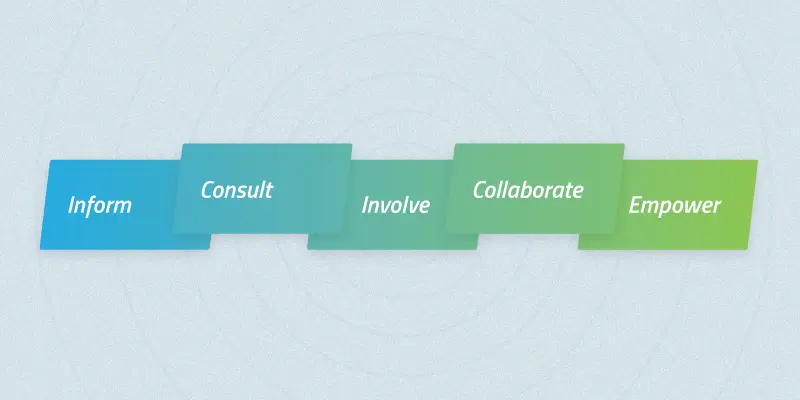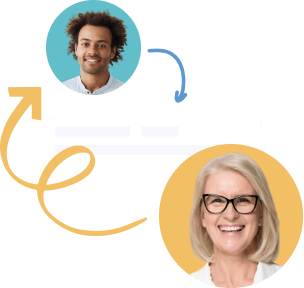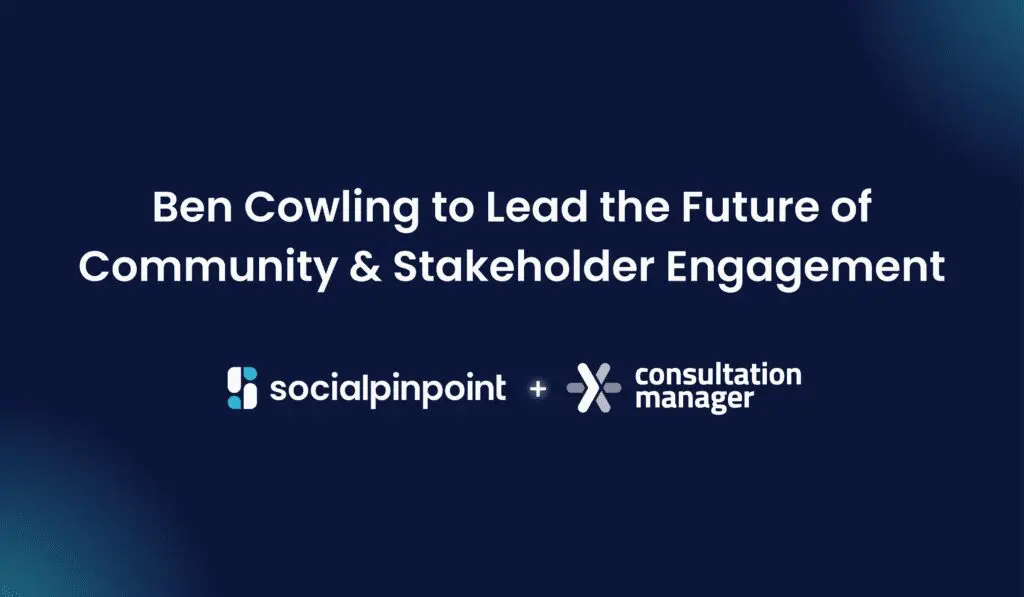The International Association of Public Participation (IAP2) developed the Spectrum of Public Participation to help clarify the role of the public in the project planning and decision-making process.
The framework differentiates between the different levels of participation depending on the project goals, time frames resources and level of concern or priority. The IAP2 spectrum includes five levels of public participation: Inform, Consult, Involve, Collaborate and Empower.
Since the spectrum’s evolution, many reputable engagement practitioners have shared their thoughts about its effectiveness. We’d like to share a few IAP2 Spectrum reflections that we found interesting.
What is the IAP2 Spectrum of Public Participation?
If you’re new to Public Participation, Graeme Stuart’s insightful article What is the Spectrum of Public Participation, is a helpful place to learn about the fundamentals of the Spectrum. A key takeaway from his article is the “empower” level doesn’t necessarily mean it’s the highest level of engagement – even though the organization is ultimately putting the end-decision into the hands of the public.
“Whereas Collaborate requires a high level of community engagement, Empower does not necessarily require the same degree of community engagement. At this level, a decision could be made by the community through a process that requires little interaction or engagement (e.g., a referendum).
Government bodies can be reluctant to establish processes at this level because of a perception that they are not permitted to delegate their decision-making authority to the public.”
Common misconceptions of the IAP2 Spectrum
Collaboration specialist, Max Hardy, higlights some common missunderstandings about the IAP2 spectrum; for example reading the spectrum from left to right.
“You start at the left and go right. Some have misunderstood the framework completely, thinking that you start off Informing, then you Consult, then you Involve etc. It’s a framework and a not a process guide.
The further to the right on the Spectrum the better it is. This was never the intention and it is why the Spectrum runs left to right – so that it does not appear to be a hierarchy like Arnstein’s Ladder of Citizen Participation. IAP2 has attempted to convey through the training, that it depends. It is about finding the most appropriate level. Trying to Collaborate on something fairly straightforward, where there is little passion or complexity, would be a waste of time. Doing a simple Consult level process for something highly complex will probably result in having to start all over again, after having done some damage.”
Implementing the IAP2 spectrum into your organizational process – The Engagement Triangle
Capire Consulting Group, a specialist community engagement company, design and deliver tailored engagement strategies to build understanding, create local ownership and to inform sustainable decision making. Capire have evolved the IAP2 spectrum into their own concept to assist their clients to understand the purpose of the engagement project and identify the most effective way to engage with the community.
The Capire Triangle was created to help meet the following criteria:
- The Engagement Triangle is a spatial tool which identifies desired outcomes of engagement based on the overarching objectives of informing decisions, building capacity and strengthening relationships.
- The Triangle should be used in early stages of planning to help clarify objectives, map stakeholders and identify appropriate tools/techniques.
- The Engagement Triangle should be used by small groups or teams to determine the intent of the community engagement.

Is the IAP2 Spectrum still relevant today?
Amanda Newbery, Managing Director at Articulous Communications and a certified IAP2 Engagement Trainer, shared her investigation about the relevance of the framework in the article IAP2 Spectrum – has it Reached its Use-by Date?
“[The IAP2 Spectrum] has two key weaknesses. It assumes it’s in charge. It assumes that we, as the organization, is in control and we choose a level for engagement for others on the IAP2 spectrum. And it doesn’t look ahead to what happens with a decision once it’s made.
I still love it.
The Model has received strong support across the Australasian industry as it acknowledges that sometimes the organization will lead the engagement process, and sometimes the community will. It also describes who will be primarily responsible for implementing the actions that arise from the decisions made. It acknowledges that there’s life beyond the decision.”
Re-imagining the IAP2 Spectrum
The IAP2 Spectrum has been a powerful tool used by engagement professionals for over 25 years. Steph Roy has been a licenced IAP2 trainer since 2005. Steph reflects on the IAP2 Spectrum in her article Re-imagining the IAP2 Spectrum. Steph believes that the spectrum may need to be modified and re-imagined to be able to keep up with and adapt to our ever-changing world.
“I’m talking about re-imagining this core tool of the public engagement practice so that it reflects a changing world, and supports practitioners, communities and organizations to keep commitments and engage meaningfully in inclusive, whole-hearted and appropriate ways.
I believe that when commitments are kept, and a process is meaningful, then trust is built with participants.
But not necessarily with the public at large, so watch out for who is not participating. Defining the levels of involvement needs to reflect everyone. Choices about non-participation are not reflected in the spectrum, and who doesn’t participate is often as powerful as who does.”
What’s the future of the IAP2 Spectrum?
Do you regularly use the IAP2 spectrum to guide your community engagement strategy? Or maybe you have you created your own model? Tell us your IAP2 spectrum reflections in the comments below.












